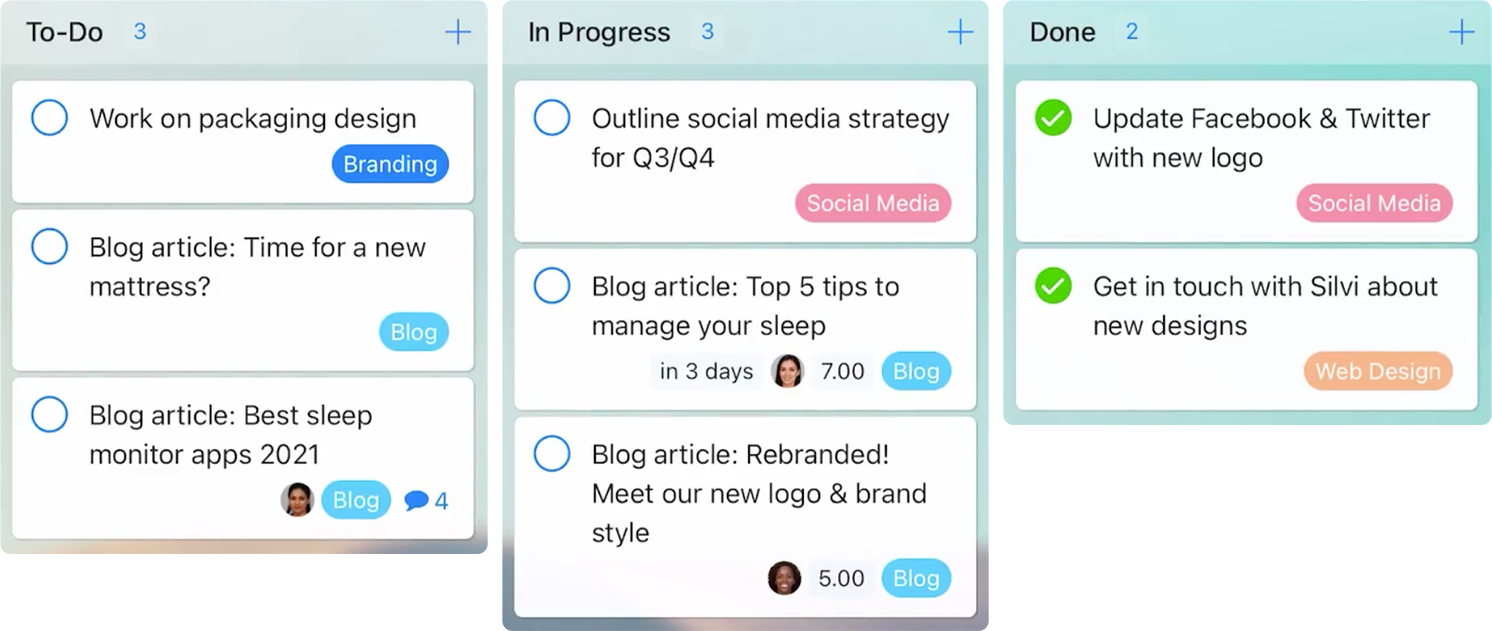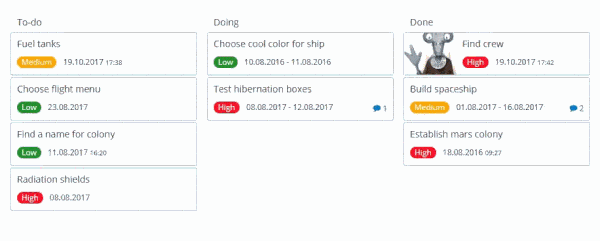
We already know that a Kanban board is great for enhancing personal productivity, but how does it fare when it comes to working in a team environment?

A Kanban board is a tool that can be best described as a visualization of a work process. Being the visual creatures that we are and the fact that our brains can process images 60,000 times faster than text, they are great for organizing just about any type of work.
Already a popular project management tool within software development companies, they are gaining traction in other industries as an effective way to help teams move forward. So, even if your team doesn’t work in software development, that doesn’t mean you won’t benefit from using a Kanban board!
What Is a Kanban Board?
A Kanban board is a visual management tool and scheduling system that is part of the Kanban method, which is an Agile framework that focuses on early releases with collaborative and self-managing teams. As a highly visual approach, it paints a picture of the development process and helps to identify any bottlenecks early on in the process, enabling you to deliver a high-quality end result.
While there are no concrete rules of Kanban, it does operate on six general practices. They are:
- Visualization
- Limiting work in progress
- Flow management
- Making policies explicit
- Using feedback loops
- Collaborative or experimental evolution
A typical Kanban board has three columns which are labelled “To-do”, “Doing”, and “Done”, which represent the different stages of the development process. The main features of a Kanban board include the following:
Kanban Board
The Kanban board itself is what is used to visualize the development process. It can be made the old-school way with a whiteboard, sticky notes, and markers, or you could go down the digital route and use an online Kanban board.
Kanban Cards
Kanban cards represent either a work item or a task within the development process. They are used to communicate progress and performance within a team and depict information such as status, cycle time, and deadlines.
Kanban Swimlanes
Not every Kanban board utilizes Kanban swimlanes. But if they do, then they are used for added organization levels. Swimlanes are visual elements on the board that flow horizontally and allow you to further distinguish tasks and/or items by categorizing them.

As mentioned, a Kanban board can be either physical or virtual. While physical ones are a great place to start, there are limitations on what they can offer — I mean, post-it notes and a marker can only take you so far in terms of storing information— which is why the focus in this article is on online Kanban boards.
5 Benefits of Using a Kanban Board Online
Many productivity tools online Kanban boards as a feature. Not only do they require less legwork compared to their physical counterparts, but some of the best online Kanban boards are often free of charge or offer free trials. In fact, so refined is Kanban board software nowadays, that most even include a Kanban board app, which is handy for teams that include off-site workers!
Accessibility is not the only perk of implementing a Kanban board in your team’s workflow process. There are many more benefits which include, but are not limited to, the following:
1. It can save time
As part of the Agile practice, implementing a Kanban board will enable your team to continuously improve throughout the development process. What this basically means is that, by using a shared visual management tool, each team member is able to see everything involved in the project process, and should any issues arise, the transparency provided will allow them to be rectified swiftly and early on in the process. This inevitably allows enough time and resources for your team to continue producing a high-quality product or service.
2. It empowers teams
As Kanban boards can be accessible to every team member involved in a project, everyone shares the responsibility for ensuring work gets moved along the board accordingly and eventually to the “Done” column. Having this kind of accountability within your team can foster communication and collaboration skills. For example, should one team member see another working on a task for longer than expected, and therefore perhaps hindering the whole process, they can communicate with each other and discuss how they can help to resolve the issue together.
3. It’s effectively designed
The visual element of a Kanban board is not only a pretty design but, as mentioned, enables us to process information easier. The best online Kanban boards will give you the option to select a layout theme and tailor your digital Kanban board, making it user-friendly and accommodating to every team member.
Your Kanban board illustrates your work stream. This visual layout showcases the movements within the project lifecycle, keeping the whole team on course and on track. Having a visual aid on hand will also ensure individuals don’t forget and prioritize urgent and important tasks.
4. It keeps productivity balanced
By sticking to the general practices of Kanban, limiting the amount of work-in-progress will keep workers from spending time on menial tasks. This limits the risk of work overload and the productivity flow being slowed down. The visualization of workflow can ensure even streams of productivity and help predict the project delivery time.
5. It’s flexible
Unlike other project management frameworks, Kanban isn’t restrictive. There are no fixed phase durations and priorities are based on the most recent data. This makes it ideal for teams in any industry to use a Kanban board to collaborate, document activity, and track their work progress.
Kanban is an accommodating method that, due to its lax practices, allows teams to utilize the board for various purposes. The column structure of a Kanban board is an ideal way to organize information for the following examples: an editorial calendar, event planning, and file archiving. Again, making it exemplary for any kind of team.
Final Thoughts
An online Kanban board can offer your team an array of workflow management solutions. If you’re interested in taking the first steps, sign your team up to Zenkit, where you can enjoy free use for up to five people.
Already part of a team of avid Kanban board users? Then share your experiences on how your team adjusted and how well it’s assisted your project in the comment section below.
Cheers,
Dinnie and the Zenkit Team






Leave a Reply